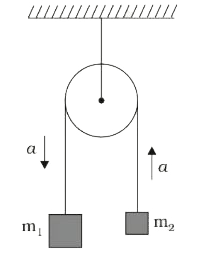Correct expression for density of an ideal gas mixture of two gases 1 and 2, where m1 and m2 are masses and n1 and n2 are moles and M1 and M2 are molar masses.
d=(m1+m2)(M1+M2)
d=(m1+m2)(n1+n2)PRT
d=(n1+n2)(m1+m2)×PRT
None of these
The correct Answer is:b
To derive the correct expression for the density of an ideal gas mixture of two gases, we can follow these steps:
Step 1: Understand the Ideal Gas Law
The ideal gas law is given by the equation:
PV=nRT
where:
- P = pressure of the gas
- V = volume of the gas
- n = number of moles of the gas
- R = universal gas constant
- T = temperature in Kelvin
Step 2: Define Density
Density (d) is defined as mass per unit volume:
d=mV
where m is the mass of the gas and V is the volume.
Step 3: Relate Mass to Moles
The mass of the gas can be expressed in terms of its number of moles and molar mass:
m=nM
where M is the molar mass of the gas.
Step 4: Substitute Mass in Density Equation
Substituting the expression for mass into the density equation gives:
d=nMV
Step 5: Substitute Volume from Ideal Gas Law
From the ideal gas law, we can express volume V as:
V=nRTP
Now, substituting this expression for volume into the density equation:
d=nMnRTP
This simplifies to:
d=PMRT
Step 6: Consider the Mixture of Two Gases
For a mixture of two gases (gas 1 and gas 2), the total mass and total number of moles can be expressed as:
- Total mass m=m1+m2
- Total number of moles n=n1+n2
The molar mass of the mixture can be expressed as:
Mmix=m1+m2n1+n2
Step 7: Final Expression for Density of the Mixture
Substituting the expressions for total mass and total number of moles into the density equation gives:
dmix=P⋅MmixRT
Conclusion
Thus, the correct expression for the density of an ideal gas mixture of two gases is:
dmix=P⋅(m1+m2)R⋅(n1+n2)⋅T
The ideal gas law is given by the equation:
PV=nRT
where:
- P = pressure of the gas
- V = volume of the gas
- n = number of moles of the gas
- R = universal gas constant
- T = temperature in Kelvin
Density (d) is defined as mass per unit volume:
d=mV
where m is the mass of the gas and V is the volume.
The mass of the gas can be expressed in terms of its number of moles and molar mass:
m=nM
where M is the molar mass of the gas.
Substituting the expression for mass into the density equation gives:
d=nMV
From the ideal gas law, we can express volume V as:
V=nRTP
Now, substituting this expression for volume into the density equation:
d=nMnRTP
This simplifies to:
d=PMRT
For a mixture of two gases (gas 1 and gas 2), the total mass and total number of moles can be expressed as:
- Total mass m=m1+m2
- Total number of moles n=n1+n2
Mmix=m1+m2n1+n2
Substituting the expressions for total mass and total number of moles into the density equation gives:
dmix=P⋅MmixRT
Thus, the correct expression for the density of an ideal gas mixture of two gases is:
dmix=P⋅(m1+m2)R⋅(n1+n2)⋅T
Topper's Solved these Questions
- GASEOUS STATEBook:NARENDRA AWASTHIChapter:GASEOUS STATEExercise:Level 1 (Q.31 To Q.60)
Explore 1 Video
- GASEOUS STATEBook:NARENDRA AWASTHIChapter:GASEOUS STATEExercise:Level 1 (Q.121 To Q.150)
Explore 1 Video
- ELECTROCHEMISTRYBook:NARENDRA AWASTHIChapter:ELECTROCHEMISTRYExercise:Level 3 - Subjective Problems
Explore 1 Video
- IONIC EEQUILIBRIUMBook:NARENDRA AWASTHIChapter:IONIC EEQUILIBRIUMExercise:Exercise
Explore 196 Videos
Similar Questions
Two bodies of masses m1andm2(<m1) are connected to the ends of a massless cord and allowed to move as shown in figure. The pulley is both massless and frictionless. The acceleration of the centre of mass is (m1−m2)n(m1+m2)2g. Find the value of n.

View SolutionThe centre of mass of a system of two particles of masses m1 and m2 is at a distance d1 from m1 and at a distance d2 from mass m2 such
View Solution
Knowledge Check
Two perifect gases at absolute temperatures T1andT2 are mixed. The absolute temperature of the mixture is T. there is no loss of energy.If m1andm2 are masses of molecules and n1andn2 are number of molecules, then
AT=T1+T22BT=n1T1+n2T2n1+n2CT=n1T1+n2T2T1+T2DNone of the aboveThe moleclar velocities of two gases at the same temprature are u1andu2 and their masses are m1andm2 respectively. Which of the following expressions are correct?
Am1u21=m2u22Bm1u1=m2u2Cm1u1=m2u2Dm1u21=m2u22Supposing Newton's law of gravitation for gravitation forces F1 and F2 between two masses m1 and m2 at positions r1 and r2 read
where M0 is a constant of dimension of mass, r12=r1−r2 and n is a number. In such a case,Athe acceleration due to gravity on the earth will be different for different objectsBnone of the three laws of Kepler will be validConly the third law will become invalidDfor n negative, an object lighter than water will sink in water
Two ideal polyatomic gases at temperature T1 and T2 are mixed so that there is no loss of energy . If F1 and F2,m1 and m2,n1 and n2 be the degrees of freedom, masses, number of molecules of the firest and second gas respectively, the temperature of mixture of these two gases is :
View SolutionThe expression relating mole fraction of solute (χ2) and molarity (M) of the solution is: (where d is the density of the solution in gL−1 and Mw1 and Mw2 are the molar masses of solvent and solute, respectively
View SolutionThe molecular velocities of two gases at same temperature are u1 and u2, their masses are m1 and m2 respectively, which of the following expression is correct ?
View SolutionThe relation between molarity (M) and molality (m) is given by : (p=density of solution (g/mL), M1= molecular mass of solute)
View SolutionTwo particles A1andA2 of masses m1,m2(m1>m2) have the same de-broglie wavelength. Then
View Solution

